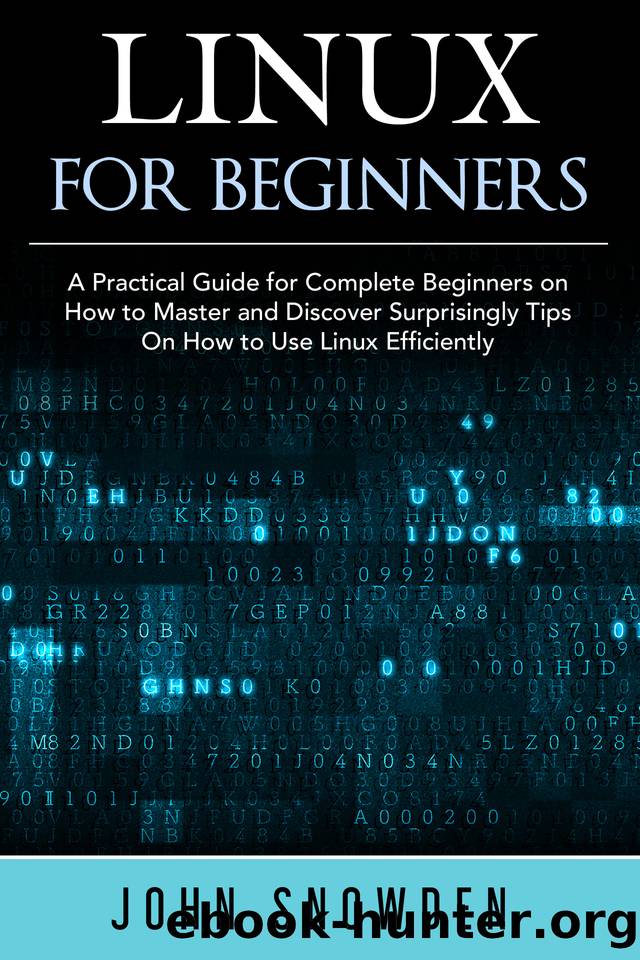Linux for Beginners: A Practical Guide for Complete Beginners on How to Master and Discover Surprisingly Tips On How to Use Linux Efficiently by Snowden John

Author:Snowden, John [Snowden, John]
Language: eng
Format: epub
Published: 2021-01-02T16:00:00+00:00
CHAPTER SIX:
LEARNING PYTHON
C++ is denser of a language than Python, which is made for rapid prototyping and quick, messy scripting. In no way is C++ meant for either of these! However, that means that C++ and Python have many differences that make it a little better to learn C++ first, to be a better programmer.
When you learn C++ first, youâre learning to be mindful of your resource usage. Python takes care of a lot for you. For example, you donât have to worry about a variableâs value when passing to a function, and you donât really have to worry that a variable is just going to be a copy of a variable, and you especially donât have to worry about freeing up memory that youâre using. When you learn C++ first, you learn to be mindful of these things from the get-go. There are ways to be mindful of them in Python simply by following good practices and not being immensely wasteful in the very essence of your code.
Second, when you learn C++ first, youâre learning to be more mindful of what youâre making . You have to explicitly type every function and variable instead of just letting it be implied. This also forces you to bear it in mind as you play around with different variables and start to become a better programmer. When youâre starting, youâll have to pay attention to the fact that variable c is an int while variable d is a string. You donât have to worry about this, but itâs good practice to keep things like value types in your head all the time as youâre working on a language.
With all of this said, there are a lot of advantages to learning Python, too. First off, itâs one of the most commonly learned and used programming languages in the world today. This means that there is a huge amount of documentation available to you as a novice Python programmerâand a lot of people who have asked the same questions that you likely will have, which means that there are people who have already given answers out there, too.
More than that, Python is an immaculate and effective language. Many people who have worked with Python have grown to love it, myself included. When you know what youâre doing with programming, working with Python is pretty fun and fast experience. Many of the things that bog you down in other languages fail to exist or have a measurable impact in Python. Weâre going through all of the stuff that we covered in the last reading in terms of Python.
If youâre running Linux, you should already have Python, simplifying the whole setup process quite a bit. You can test this out by opening up the Terminal and then typing python and pressing enter. If it launches Python, then youâre all set. If not, youâll need to go to Python.org and get it, but this really shouldnât be an issue on Linux distributions.
If it launches as anything other than Python 2.
Download
This site does not store any files on its server. We only index and link to content provided by other sites. Please contact the content providers to delete copyright contents if any and email us, we'll remove relevant links or contents immediately.
Grails in Action by Glen Smith Peter Ledbrook(9163)
Sass and Compass in Action by Wynn Netherland Nathan Weizenbaum Chris Eppstein Brandon Mathis(8808)
Azure Containers Explained by Wesley Haakman & Richard Hooper(7438)
Configuring Windows Server Hybrid Advanced Services Exam Ref AZ-801 by Chris Gill(7431)
Kotlin in Action by Dmitry Jemerov(7263)
Running Windows Containers on AWS by Marcio Morales(6979)
Microsoft 365 Identity and Services Exam Guide MS-100 by Aaron Guilmette(5398)
Microsoft Cybersecurity Architect Exam Ref SC-100 by Dwayne Natwick(5206)
Combating Crime on the Dark Web by Nearchos Nearchou(4978)
The Ruby Workshop by Akshat Paul Peter Philips Dániel Szabó and Cheyne Wallace(4665)
Management Strategies for the Cloud Revolution: How Cloud Computing Is Transforming Business and Why You Can't Afford to Be Left Behind by Charles Babcock(4525)
Python for Security and Networking - Third Edition by José Manuel Ortega(4231)
The Age of Surveillance Capitalism by Shoshana Zuboff(4209)
Learn Wireshark by Lisa Bock(4113)
The Ultimate Docker Container Book by Schenker Gabriel N.;(3885)
Learn Windows PowerShell in a Month of Lunches by Don Jones(3681)
DevSecOps in Practice with VMware Tanzu by Parth Pandit & Robert Hardt(3564)
Windows Ransomware Detection and Protection by Marius Sandbu(3540)
Blockchain Basics by Daniel Drescher(3507)
